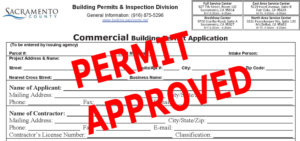CalGreen for Your New Home
CalGreen for Your New Home

CalGreen for your new home consists of two parts.
This first part is filling out the correct CalGreen Checklist for your jurisdiction. The second part is ensuring your architectural, electrical, plumbing and site plans include all of the CalGreen requirements.
Filling out the checklist wrong can add costs and delays to your project. Failing to review the architectural and engineering plans for CalGreen compliance can cost you more.
The problems will come not during your permit review by your building department. They will come at the end of your project during the final inspection. This is when you find out that the required items were not included in your architect’s design and, consequently, were never installed by your contractor.
Unfortunately, as the owner, you will have to pay for these mistakes. They may also result in delays to your occupancy of your new home.
CalGreen Explained
CalGreen, or CAL Green, are acronyms for the California Green Building Standards Code. This code is part of the California state building codes that all new projects must comply with. CalGreen for your new home includes sustainable practices in the design and construction.
The CalGreen code was created to require “sustainable” building practices for all new residential and commercial buildings, including alternations to existing buildings. So what, exactly, are sustainable building practices?
“Sustainable” practices have no generally accepted clear definition. At the core they attempt to conserve resources, use recyclable materials, protect nature and create a healthy environment. In addition they strive for quality in construction and materials. By doing so, fewer resources, and costs, will be required over the life of the building.

The CalGreen Code is the state’s attempt at legislating the above generic concepts into the realities of building construction. The code places requirements on the project site, demolition, energy efficiency, water conservation, building materials, moisture control, pollutant control, and occupant comfort. Additionally, it requires a construction waste management program that must be maintained during construction.
Generally speaking, the code does a reasonable job of balancing sustainable design with the costs to your project. Further, the state code gives your local jurisdiction wide latitude in how it adopts and enforces the code.
Certain jurisdictions, such as Santa Rosa, have chosen to adopt and enforce all aspects of the CalGreen code. This is in response to the environmentally conscious residents of Sonoma County. This also takes into account the economic advantages of this affluent area.
For comparison, Bakersfield and other Central Valley towns, has made little effort to encourage CalGreen compliance. This results in lower costs for home construction.
The CalGreen code is the only California building code that provides such leeway to your local building department. For this reason, it is very important to understand your local requirements.
We regularly see CalGreen checklists put together by architects that simply don’t know the local requirements. They take an HCD or AIA (Architects Institute of America) checklist and paste it into your permit set with every box checked. They have now committed your project to thousands of dollars of unnecessary costs! The unfortunate part is they don’t even realize what they have done.
Saving Money on Your CalGreen Compliance
CalGreen for your new home is going to cost you money. How much money depends on who is designing your home, and how much they know about the CalGreen Code.
Your building permit application must include a CalGreen Checklist. The checklist is prepared either by your architect, or a CalGreen specialist such as our firm. The checklist itself may be published by your local building department. Alternatively, you may be required to submit the one published by the California Department of Housing and Community Development (HCD).
While every checklist is different, there are some general tips to consider when filling yours out.
The most important tip is to not check more items than are necessary. Every item you check will cost your project money. When in doubt, mark it “NA” (not applicable). If the building department comes back as says you need it, fine. A good example would be your doing an interior remodel. Your checklist has a number of site requirements. Since your work is inside your project you do not have to comply with any CalGreen site requirements. All checklist items related to site work should be marked “N/A”.
Some checklists, like the HCD one, contain not only the mandatory measures, but also the Tier 1 & 2 voluntary measures. Unless your jurisdiction has adopted Tier 1 or Tier 2, these requirements should be marked “N/A”.
The AIA CalGreen checklist is also full of items that likely do not apply to your project. Your checklist should be carefully edited to remove the many items that will not apply to you. Another problem in using the AIA checklist is that the checklist is in AutoCad format. This format makes it very time consuming to edit properly. We have seen many projects being submitted with this checklist unedited. This can be a costly mistake for the project if the building department chooses to enforce the checklist you submitted.
At CalGreen Energy Services we carefully evaluate every checklist item with skepticism. Our staff has decades of design and construction experience. This code and construction industry knowledge allows us to critically evaluate each and every item.
Our goal is to never commit a building owner to even one unnecessary checklist obligation. We will work directly with your local building department when necessary to ensure only those code requirements that are clearly applicable to your project are included in the permit submittal.

CalGreen Inspections
All new and remodeled projects in California require a final CalGreen inspection. This applies to both residential and commercial projects. There can be a significant impact on the project depending on who is required to perform the inspection.
Your local building department determines who is required to perform the CalGreen inspections. There are two possible inspector requirements. The first, and most common, is that the building department’s inspector includes the CalGreen inspections as part of his final close-out inspections.
The other possibility is that your building departments requires this be performed by an ICC Certified CalGreen Special Inspector. An ICC certified inspector has been specifically trained in the California Green Building Standards Code. The certification requires on-going training in order to be able to perform the inspections. Some jurisdictions require the ICC certified CalGreen inspector be approved and specifically listed in their area as a “special inspector”.
At CalGreen Energy Services we are specialists in the CalGreen Code. CalGreen is our only business. If you have a CalGreen question please feel free to give us a call. We are happy to share our knowledge.

Gary Welch has over 35 years experience in the field of sustainable building design. He is the CEO of CalGreen Energy Services. Gary is an ICC Certified CalGreen Special Inspector and Plans Examiner.
Call us today and let us show you how we can help with your project.
Gary Welch
Email: gary@calgreenenergyservices.com
Phone: 707-328-5299

CalGreen Checklist

Gary Welch has over 35 years experience in the field of sustainable building design. He is the CEO of CalGreen Energy Services. Gary is an ICC Certified CalGreen Special Inspector and Plans Examiner.


